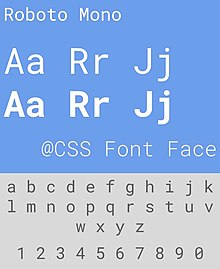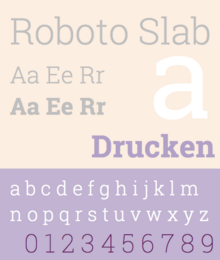|
Roboto
Roboto (/roʊˈbɒt.oʊ/)[2] is a typeface family developed by Google. The first typeface was created as the system font for its Android operating system, and released in 2011 for Android 4.0 "Ice Cream Sandwich".[3] The entire font family has been licensed under the Apache license.[4] In 2014, Roboto was redesigned for Android 5.0 "Lollipop". UsageRoboto is the default system font on Android, and since 2013, other Google services such as Google Play, YouTube, Google Maps,[5] Google Images, and more. In 2017, Roboto was used on the LCD countdown clocks of the New York City Subway's B Division lines. Roboto Bold is the default font in Unreal Engine 4, and in Kodi.[6] Roboto Condensed is used to display Information on European versions of Nintendo Switch packaging, including physical releases of games. Utsav Network uses Roboto for its wordmark.[7] Since October 2022, Global News has also used Roboto in its on-air presentation, however the font is not used in main network presentation. The United Nations uses Roboto on its website and in official documents.[8] HistoryAndroid's previous system typeface, Droid Sans, was designed for the low-resolution displays of the very early Android devices, and did not display well in larger, higher-resolution screens of later models.[9][10] It was decided that a more modern typeface, designed from scratch, was needed for the newer displays. Early developmentThe new typeface, Roboto, was designed entirely in-house by Christian Robertson who previously had released an expanded Ubuntu Titling font through his personal type foundry Betatype.[11][12] The font was officially made available for free download on January 12, 2012, on the newly launched Android Design website. Compared to the humanist sans-serif Droid Sans, Roboto belongs to the neo-grotesque genre of sans-serif typefaces. It includes Thin, Light, Regular, Medium, Bold and Black weights with matching oblique styles rather than true italics. It also includes condensed styles in Light, Regular and Bold, also with matching oblique designs. 2014: "Material Design" redesignIn 2014, Matias Duarte announced at Google I/O that Roboto was significantly redesigned for Android 5.0 "Lollipop".[11][13] Punctuation marks and the tittles in the lowercase "i" and "j" were changed from square to rounded, the bottom surface of the top part of the number "1" points downwards instead of horizontal, the tail part of the numbers "6" and "9" have been slightly shortened (in resemblance to "Trebuchet MS"), and the entire typeface was made “slightly wider and rounder” with many changes in details.[11][13] The newly-redesigned version of Roboto is also offered in a wider range of font weights, adding Thin (100), Medium (500), and Black (900) alongside Light (300), Regular (400), and Bold (700).
Language supportRoboto supports Latin, Greek (partial) and Cyrillic scripts.[14] On Android, the Noto fonts are used for languages not supported by Roboto, including Chinese (simplified and traditional), Japanese, Korean, Thai and Hindi (as of January 2014),[15] and Droid fonts as of 2008. VariationsRoboto Mono
Roboto Mono is a monospace font based on Roboto. It is available in seven weights: thin, extra-light, light, regular, medium, semi-bold and bold, with oblique stylings for each weight.[16] Roboto SerifRoboto Serif is a companion typeface with serifs designed by Greg Gazdowicz of Commercial Type. It was debuted in 2022 to fill the serif niche.[17] Roboto Slab
Roboto Slab is a slab serif font based on Roboto. It was introduced in March 2013, as the default font in Google's note-taking service Google Keep.[18] (The font was changed to the sans-serif Roboto in 2018.)[19] It is available in four weights: thin, light, regular and bold. However, no oblique versions were released for it. In November 2019, the typeface was updated and added 5 new weights: Extra-Light, Medium, Semi-Bold, Extra-Bold and Black, and a variable font axis ranging from 100 to 900. It also was modified with some characteristics from the sans-serif Roboto and to slightly resemble most slab-serif typefaces, such as "R", "K", "k", "g", "C", "S", etc. Roboto FlexReleased in 2022, Roboto Flex is the variable font version of Roboto.[20] Roboto Flex has 12 adjustable axes, including optical size.[21] Notably, the static font version of Roboto does not have weights 200 (Extra Light), 600 (Semi Bold), and 800 (Extra Bold), which can be achieved by Roboto Flex via the weight axis. Roboto Flex supports Latin, Greek, and Cyrillic characters. Potential inclusion as the new Android system fontRoboto Flex was still not used as the default system font in Android, potentially replacing classic Roboto. Meanwhile, Google started to use Google Sans Text as the default system font for Android system apps (e.g. Settings) in Google Pixel devices, following other Android OEMs who introduce custom fonts to their system apps. The Android source code has been updated to include the font as part of Android 14, though there are no official plans to switch the default system font from Roboto to Roboto Flex.[22] HeeboHeebo is an extension of Roboto that includes Hebrew characters.[23] Inter
Inter was designed in 2016 by Rasmus Andersson who wanted a font that was easier to read on computer screens than Roboto while retaining its vertical proportions.[24] Earlier versions of Inter (then "Interface" and "Inter UI") included glyphs and followed the vertical glyph metrics (ascender and descender) from Roboto, while Roboto glyphs were included as a fallback for characters which have not been (re-)designed in Inter. Inter changed its vertical glyph metrics since 2018, making it different from that of Roboto.[25] Due to this condition, the typeface had to be released in two combined licenses: the SIL Open Font License for original glyph designs for Inter and Apache License for the fallback Roboto glyphs and outlines. This exception was removed in 2020 after Roboto was re-licensed from Apache to OFL.[26] Inter also has an experimental "Display" version, a font which has less letter spacing and has linear endings of letters.[27] Another variant with similar purpose, Inter Tight, is specifically designed for Google Workspace and other applications that do not support control over letter spacing.[28] The latter variant shares the same glyph shapes as Inter, while the former contains redesigned glyphs which will be introduced in a future version of Inter. The Apple system font San Francisco is similar to the Inter font. PibotoPiboto is a forked version of Roboto, including the original character styles as used before the 2014 redesign. It is specifically designed and currently the system font of Raspberry Pi OS (then Raspbian) as part of their desktop UI redesign.[29]  ReceptionGoogle developed Roboto to be "modern, yet approachable" and "emotional,"[30][31] but the initial release (i.e., before the Android 5.0 redesign) received mixed reviews. Joshua Topolsky, Editor-In-Chief of technology news and media network The Verge, describes the typeface as "clean and modern, but not overly futuristic – not a science fiction font".[32] However, typography commentator Stephen Coles of Typographica called the initial release "a Four-headed Frankenfont", describing it as a "hodgepodge" of different typographic styles which do not work well together. Coles later commented positively on the redesign and stated that it corrected many problems of the initial release.[11] See also
References
External linksWikimedia Commons has media related to Roboto.
|
||||||||||||||||||||||||||||||||||||||||||||||||||||||||||||||||||||||||||||||||






